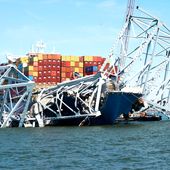RESOLUTE BAY, Canada - Steadily melting Arctic ice is not just exposing vast unexplored fishing stocks and mineral wealth. It’s also rapidly making the Northwest Passage — the passable sea route sought by Henry Hudson and other explorers of the 16th and 17th centuries — fully navigable in the summer.
That, in turn, is forcing Canada to confront a range of sovereignty issues, including disputes with the United States and other Arctic neighbors.
Canada considers the Northwest Passage its internal waters, but the United States insists it is an international strait.
“The heart of the dispute is the transit of international shipping, and who gets to set rules,” says Rob Huebert, associate director of the Center for Military and Strategic Studies at the University of Calgary in Alberta.
An open Northwest Passage would cut 5,000 nautical miles from shipping routes between Europe and Asia.
If the passage’s deep waters become completely ice-free in summer months, they would be particularly enticing for massive supertankers that are forced to plow around the tip of South America because they are too big to pass through the Panama Canal.
The search for the Northwest Passage became an obsession for European explorers once it became clear that the vast continents of North and South America stood between Europe and the Orient.
One of the most famous explorers, Henry Hudson, made four unsuccessful attempts to find a sea route to China in the early 17th century — one up the Hudson River and three through Arctic waters. Hudson’s career ended when a mutinous crew set him adrift in a rowboat somewhere in the Hudson Bay and returned to England.
It took nearly three centuries before Norwegian explorer Roald Amundsen, known as “the last of the Vikings,” became the first to make it through the entire length of the passage. He did it with a 70-foot fishing boat in 1903.
According the Canadian Ice Service, the amount of ice in Canada’s eastern Arctic Archipelago decreased by 15 percent between 1969 and 2004. In parts of the Western Arctic, the ice has receded by 36 percent.
Even before the passage becomes ice-free, other developments are expected to create a host of new security and law-enforcement issues. Among those trends: the world’s increasing thirst for oil and gas, exploration for precious metals and diamonds, growing demands on the northern fishery and a steady rise in ecotourism and adventure travel.
Canada has at least four territorial disputes with its Arctic neighbors — two with the United States, one with Russia and one with Denmark — that could flare up with the receding ice.
Canada already accuses Denmark of launching invasions of its Arctic domain by sending ice-reinforced frigates, the HDMS Vaedderen in 2002 and HDMS Triton in 2003, to stake a Danish claim to Hans Island.
The tiny pimple of rock and ice, home to a seal colony that attracts the occasional hungry polar bear, is so small it does not even show on most maps. But neither side is backing down.
The Danes, who already own Greenland, say they own Hans Island as well. During both trips, Danish marines landed, raised the kingdom’s flag and left plaques asserting their claim.
Bigger disputes
Canada responded by holding its largest-ever Arctic military exercises last year. It plans to hold an even bigger drill in the summer of 2007.
“If it was the only Arctic issue, I’d say, ‘Who cares? It’s a piece of rock,’” Mr. Huebert says. “But the problem is, what precedent do we set if we seem to be not too concerned?”
Far more important, he says, is Canada’s dispute with the United States over the Northwest Passage, as well as a dispute over the boundary between Yukon and Alaska in the Beaufort Sea.
A Foreign Ministry official in Ottawa says Canada insists that the border between Alaska and Yukon extends in a straight line into the Beaufort Sea along the 141st meridian, more or less parallel to the shore.
The U.S. holds that the boundary line is slanted more toward the east and is an equidistant line perpendicular to the coastline.
“There are arguments to support both sides, to be perfectly honest,” Mr. Huebert says. “I’m a Canadian, but the arguments that the Americans come forward with, to a large degree, are the very same arguments that we came forward with in the Gulf of Maine.”
The ultimate issue, however, is over control of the resources.
The best course of action for Canada and the United States, Mr. Huebert says, would be to negotiate a joint management scheme for the Beaufort Sea without necessarily saying that one side was right and the other wrong.
“We have very similar, shared interests,” the think tank director says. “Both of us want to see the development of the oil and gas resources.”
Canada and the United States came to diplomatic loggerheads on the Northwest Passage in 1985, when a U.S. Coast Guard icebreaker transited the passage without asking permission from the Canadian government.
In 1988, then-Prime Minister Brian Mulroney and President Reagan signed the Arctic Co-operation Agreement, which allows the Coast Guard to use the passage after notifying Canada.
Canada, in turn, cannot refuse permission.
Catching up
Canada also has disagreements with Russia over how the Russians determined their continental shelf.
Under the United Nations Convention on the Law of the Sea, which Canada ratified in November 2003, Canada has 10 years from ratification to determine its continental shelf.
Canada’s government allocated $70 million for that project. But it is way behind the United States, Russia and Denmark in mapping its claim.
Under international law, coastal countries can claim 200 nautical miles from their shores as an Exclusive Economic Zone, where they have sovereignty over the natural resources.
However, if a country can demonstrate that its continental shelf, the continuation of the continent under the water, extends further, it can claim up to 150 additional miles, Mr. Huebert notes.
“We already disagree with the Russians, but there is a chance that we would disagree with the Danes and the Americans on how they draw their continental shelf.”
Not everybody agrees Canada’s sovereignty in the Arctic is seriously threatened.
Franklyn Griffiths, a professor emeritus of political science who holds the George Ignatieff Chair of Peace and Conflict Studies at the University of Toronto, says Canada has a law-enforcement issue in the Arctic, not a sovereignty issue.
“In the case of the Northwest Passage, we do have a challenge, but it’s not a live one,” Mr. Griffiths says.
In fact, he says, the warming of the Arctic and melting of the ice can make the waters of the Northwest Passage more dangerous for navigation because of the release of deadly multiyear ice, dubbed “floating steel.”
Also, by the time the Northwest Passage becomes completely ice-free, a much more viable route probably will open through the top of the Arctic, he says.
Moreover, after the September 11 attacks, it became much easier for Canada to convince the United States that U.S. homeland security would be better protected by Canadian law than the lax laws governing international straits, Mr. Griffiths says.
Should the United States decide to challenge Canada’s claim to the waters of the Northwest Passage and send out an ice-strengthened oil tanker, there is little that Canada could do.
“Are we going to sink an oil tanker in the Canadian Archipelago? Are we going to put an icebreaker in front of it and try to block it and risk an accident? Are we going to bomb it? Are we going to torpedo it as it comes into open water?” Mr. Griffiths asks. “These things are silly.”
Snowmobile defense
Years of cost cutting reduced Canada’s ability to roam, let alone police, the waters it claims as its own.
Canada’s military presence in the North is limited to the Canadian Forces Northern Area (CFNA) headquarters in Yellowknife, Northwest Territories, and two smaller detachments in Whitehorse, Yukon, and Iqaluit, Nunavut.
Col. Norm Couturier, the CFNA commander, acknowledges that he faces a huge logistical challenge.
The CFNA is spread over 1.5 million square miles of some of the world’s most inhospitable and sparsely populated regions.
There are no roads connecting the region year-round with the rest of Canada, and virtually everything has to be sent by sea or airlifted.
To oversee this huge expanse, Col. Couturier has a staff of about 200 Regular Forces soldiers with four Twin Otter transport utility planes and 1,400 Canadian Rangers on snowmobiles.
But as the melting ice generates new interest in the Arctic, Canada is beginning to pay attention.
In April, Canada’s government started putting the first pieces of the puzzle in place in foreign- and defense-policy white papers, where the Arctic features prominently, Mr. Huebert says.
“It’s the most I’ve ever seen in any of the white papers,” he says. “To see the significance given to the Arctic in both the defense- and foreign-policy papers to that degree, I find it very amazing.”
A blind eye
One of the priorities of the Canadian government in the Arctic should be increasing surveillance capability, Mr. Huebert says.
Canada’s RADARSAT-1 satellite gives only limited real-time information about the Arctic.
“There are big gaps,” Mr. Huebert says. “We do not have a 24-hour, seven-days-a-week surveillance of the North.”
Even if the satellite detects something suspicious, Canada has limited capability to send long-range patrol aircraft to investigate.
The North Warning System, positioned along the northern perimeter of Canada, allows authorities to see aircraft coming up to the radar sites. But once aircraft pass beyond these sites, they are not followed and tracked, Mr. Huebert says.
“And NAV Canada doesn’t have radar sites throughout the North,” Mr. Huebert says, referring to Canada’s civilian air-traffic authority. “They’ve got some coverage, but it’s not 100 percent. So the problem that we have right now is that there are very significant gaps in terms of what we know [is] going on.”
Canada is preparing to launch a new satellite, RADARSAT-2, which will dramatically improve surveillance capabilities in the North, the think tank official says.
Canadian forces are buying unmanned drone aircraft for surveillance of the Arctic. The government also committed to replacing the four Twin Otter aircraft, the workhorse of Canadian Forces in the Arctic, with newer and longer-range planes.
Although Canada considers itself an Arctic nation, its thin-skinned navy vessels — like those of the U.S. Navy — cannot operate in the Arctic except for a few weeks in August and September when the waters are ice-free.
Canada should follow Denmark’s example and build at least one or two ice-strengthened navy vessels, Mr. Huebert says.
Denmark has four ice-strengthened Thetis-class frigates that can break through more than three feet of ice.
Getting assertive
Having Arctic-capable ships will send a strong message to the international community that Canada is the master of its Arctic domain, Mr. Huebert suggests.
But in the short run, Canada will have to assert sovereignty in the Arctic by using enhanced patrols of Regular Forces soldiers and Canadian Rangers on snowmobiles. Ranger patrols also could be used to assert Canadian sovereignty over Hans Island, he says.
There would be more symbolism in the Inuit going there than if Canadian Forces were to parachute regular troops, he says, using the Canadian term for Eskimos.
“After all, Hans Island is really theirs,” Mr. Huebert says. “Is it provocative? Well, how much less provocative than Danes landing sailors as they have.”



Please read our comment policy before commenting.